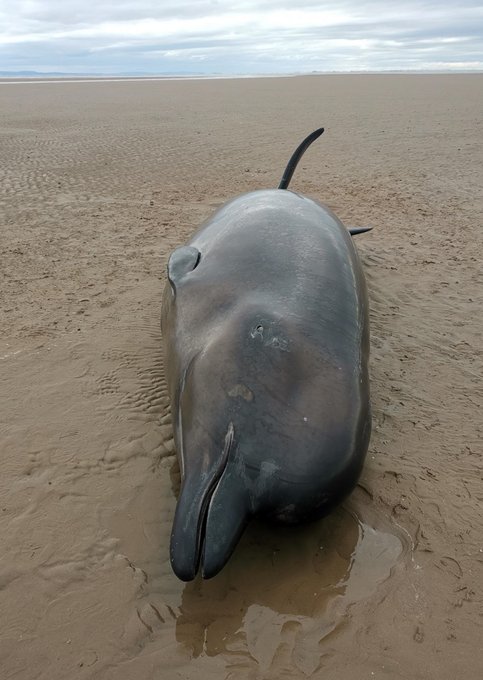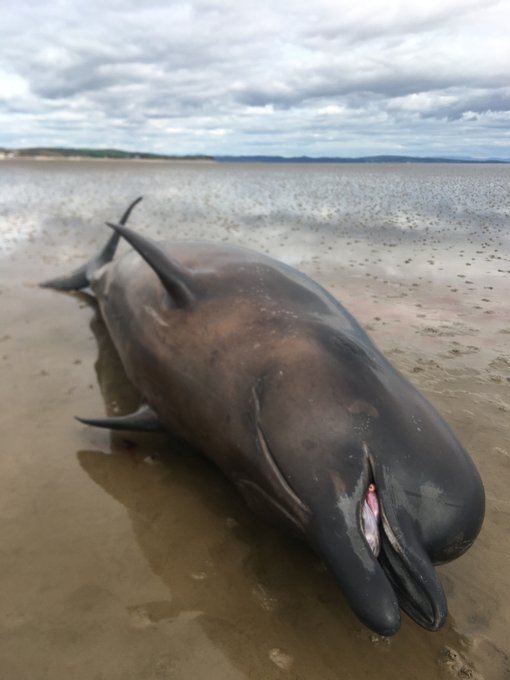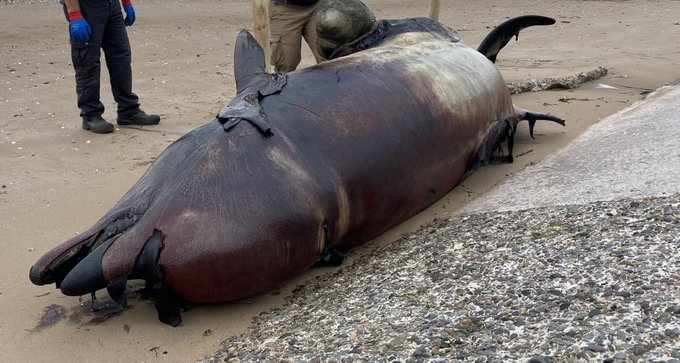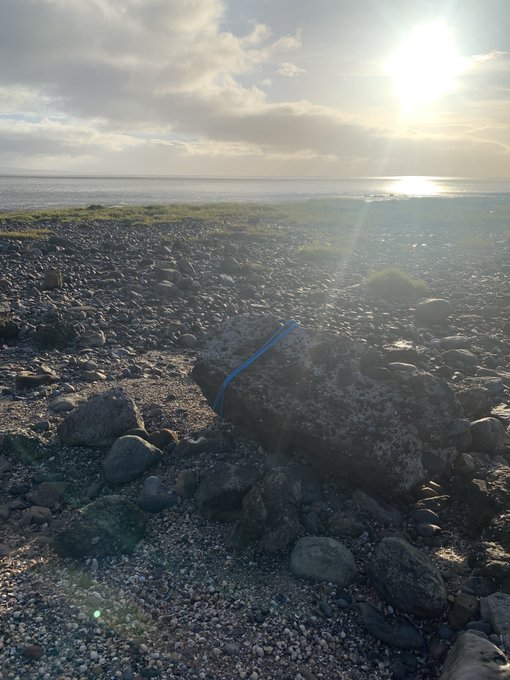Whales, including the beautiful Humpbacks, are some of the most incredible animals on the planet! Some of these amazing mammals can reach truly colossal sizes, which makes them the undisputed Kings of the Ocean!
And it’s not just their size that sets them apart! The longest recorded dive of a whale is some 222 minutes long. That makes the human record of 24 minutes look like child’s play! And Sperm Whales, for example, are able to dive up to depths of 6562 feet, while the record for a human dive is just 1090 feet. But they only managed that with the aid of oxygen tanks and years of training. So, when it comes to living in the ocean, whales have us beat, flippers down! And with few natural predators, the ocean is a pretty happy home for most whales! Except nearly 2000 whales and dolphins beach themselves on the shore every year! Sadly, many of these amazing animals perish, unable to survive out of their watery domain.
It doesn’t make sense, though. Why is this happening, and why does it keep happening? What else is lurking out in the ocean? What is driving these creatures to flee from the sea? Hold your breath, as we dive into this mystery and more instances of animals escaping their habitat.
Whale Evolution
Whales are cetaceans; part of an order of entirely aquatic mammals that are perfectly adapted to live in the ocean, like nature’s submarines. They have streamlined bodies that are able to sail through the water, flippers to aid in steering, and giant tails to powerfully propel them forwards!
However, on the flip side, all of these adaptations can make beaching a death sentence for a whale. No longer supported by the buoyancy of water, a whale’s body will crush itself under its own weight on land!
With their circulation restricted, this results in a deadly toxin build up in the whale’s blood. Whales also have a bulky layer of blubber, in some species it’s 11 inches thick, that keeps them warm in the cold depths of the ocean, which can reach a freezing 39°F. But beached on land, this fatty layer becomes a sweaty straitjacket that causes them to rapidly overheat! Hence rescuers have to continuously splash water on a beached whale to keep it cool.
And though whales can breathe on land because they’re mammals, like us, if any water from incoming tides enters their blowhole, they can drown in the shallow waves! Beaching is a terrible fate for any whale and one that, you would think, they’d avoid at all costs. But on the contrary, beached whales are on the rise! Since the 1990’s, cetacean stranding reports around the world have increased worryingly, with heart-breaking
mass strandings becoming increasingly common! What is driving whales to flop out of the ocean? Could it be that they’re trying to return to land?Weird as that concept may be, it’s not as insane as it sounds. Whales have only lived in the ocean for the last 40 million years. Prior to that, these aquatic creatures were land-dwellers!
You may find that hard to believe, but have you ever wondered why whale tails move up and down while sharks and other fish tails move side to side? That’s because whales’ spinal columns originally evolved to walk! Their vertebrae were designed to undulate up and down over land, rather than sway side to side swimming through water.
The first ancestor of whales evolved on land over 50 million years ago and is known as
Pakicetus. However, Pakicetus barely resembles modern day whales. In fact, they looked more like dogs with long bodies that could reach 6 feet in length, with a thick neck and a robust tail. Their long, snouted muzzles and menacingly large teeth evolved specifically for eating meat. The only common feature shared with modern whales is a separate bony wall covering the inner ear region. This is a unique biological quirk and is one of the reasons why whales have superior underwater hearing.Nevertheless, Pakicetus didn’t hang around on land for long. Five million years later, its successor Ambulocetus had evolved to adopt a more aquatic lifestyle.
Ambulocetus had shorter legs, with wide and flat feet that acted more like paddles, and a longer and even more muscular tail!
They look like a hippo after a crash diet! Which makes sense, as whales’ closest living land relatives today are hippos. Although the next prehistoric whale ancestor down the line, known as
Kutchicetus, was even more streamlined, and resembled an otter crossed with an anteater!
Its appearance may give the impression that evolution has seriously veered off course. But despite its weaselly appearance, Kutchicetus was a key steppingstone in whale evolution! Its nostrils were positioned further back along its snout, starting the development of the blowhole on the top of a whale’s head we see today!
Though the creatures we can most recognize as whales didn’t evolve until the
Basilosaurid whales came along, between 41 and 33 million years ago. This is where whale skeletons truly evolved from upright animals to long tail flukes. Nevertheless, Basilosaurid whales still had legs! Just freaky little ones, like a T-Rex’s tiny arms! Their hind limbs served no effective function, and most likely evolved to be internal to the body wall. Even to this day, some modern whales are discovered with tiny hindlimbs inside their body cavity! A hangover of their prehistoric past!

With the Basilosaurid now living in the ocean because of the abundance of food, this didn’t mean they suddenly developed gills. These creatures still had lungs and breathed air like any other mammal. But they had to learn to hold their breath really well. While they could visit the surface for air when they were conscious, they still had to sleep. And so, they evolved to sleep underwater through a combination of 2 methods: by either resting quietly in the water, vertically or horizontally, or sleeping while swimming slowly next to another animal.
You can still see this behavior in many whale species today, like sperm whales! These massive mammals rest vertically for less than 7% of the day while staying close to the water’s surface for when they need air! That does not sound easy, though it goes to show just how far evolution will stretch when it comes to sticking near a sustainable food source!
Sleeping, Bubbling Sperm Whales by Susan Bird (Way of the Whale) But it was also at this point in their development where Basilosaurid whales scaled up in size. They could reach up to 70 feet long, whereas today, their successors such as the blue whale can reach a length of 110 feet and weigh a whopping 219 tons! There’s an urban myth that their heart is the same size and weight as a 14 ft by 6 ft Volkswagen Beetle! But in reality their heart is only about 5 ft long and 4 ft wide, weighing in at 400 lbs, the same weight as your average motorcycle! That is still pretty impressive, though.
In fact, blue whales are the largest creatures to have ever existed on the planet, bigger than even the largest dinosaurs! Whales have literally outgrown their ability to live on land. So why do they keep rolling ashore? Has living in the ocean for all those millions of years been that terrible?
Why Do Whales Beach Themselves?
With whale beachings on the rise, it does appear that there is something driving whales ashore. Typically, a beached whale is old, sick, or injured and too weak to navigate the deep ocean, so it swims into shallower waters to recover.
However, the tides can change quickly, and leave a whale floating in coastal waters high and dry on the beach in a low tide. A dangerous mistake for a whale to make! But sometimes, even for healthy whales, the ocean isn’t easy to navigate. There are certain areas of the coastline that are death traps for whales! Such as the notorious Farewell Spit, a 16-mile stretch of sand on the northernmost tip of New Zealand’s South Island.
Mass whale strandings have occurred here as recently as March 2022, when 31 pilot whales stranded across 1.9 miles of coastline died, despite rescuers best efforts to save them.
Mass strandings are a common occurrence among highly social whale species, such as pilot and melon-headed whales. If one whale beaches, its cries of distress results in its pod hanging around in dangerously shallow waters unwilling to abandon their family member. That is, until they themselves end up beached! In this case, though rescuers managed to refloat 5 of the whales, 2 of them later washed back up on the beach! How come they can’t seem to escape? Scientists think this is because the spit creates a shallow seabed in the bay with mile-wide sand flats.
Swimming in these shallow waters confuses the whales’ navigation systems, as their echolocation ability is designed to work in deeper waters. Lost among the sand banks, the whales are caught out in the tides and end up beached. As such, the site has seen 11-pilot whale strandings in the past 15 years! However, the worst occurrence by far was in February 2017, when a shocking 700 whales were beached, resulting in 250 of the poor things passing away! This area should be marked with a giant black X on whales’ maps, as it seems no whales can survive swimming in these parts!
Whale Stranding, Farewell Spit, Golden Bay, New Zealand, Feb 11th 2017 by tweetingsparrow However, not all whales are getting lost. Some of them do appear to have recently started fleeing the ocean, such as a deep-sea whale which, prior to the 1960s, had rarely ever been seen.The beaked whale is one of the most mysterious whale species, as it resides mainly in the deep ocean and regularly dives to depths of 6500 feet to hunt for squid! For years, these whales eluded researchers.
However, these days they keep washing up ashore! Between 1995 and 2020, 35 beaked whales were reported stranded in 16 separate events in Alaska. There have also been increasingly frequent beachings of beaked whales along the coastline of Guam between 2007 and 2019. To discover the cause of this, we need to dive beneath the surface. In 1933, the U.S Navy started using sonar technology aboard their vessels. Sonar is tech used to detect underwater objects by emitting sound pulses and measuring the soundwaves that are reflected back. But since then, the ocean has been getting increasingly LOUD! In particular, a type of sonar called Mid-Frequency Active Sonar that has been deployed by the U.S Navy to detect submarines, produces a deafeningly piercing sound! It’s so loud, divers have described feeling the sound vibrate through their bodies!

Imagine what that sound is like to the exceptional hearing of a whale! These are creatures that can hear sounds as high-pitched as 200 kilohertz, while humans can only detect sounds up to 20 kilohertz! And unfortunately, Beaked Whales inhabit the same location where many of these sonar tests are conducted for up to 10 hours at a time!
In addition, sound travels faster underwater as it is a denser medium than air. As a result, the sound waves reach a whale’s ears with tremendous energy, causing a more intense barrage of sonar, which damages the whales’ ears. This not only makes it harder for them to navigate, but the whales’ damaged ears mean they are unable to dive to hunt because they can’t equalize the pressure in them without excruciating pain. So, weak and disoriented,
many of them end up drifting into shallower water and beached on the shores!
Between 1960 to 2004, there have been a total of 121 mass stranding events of beaked whales. Many of the beaching events happened in areas where US Navy and NATO training exercises were taking place. Though the Navy would sure like to put this down to coincidence, research has found a strong link between military exercises using anti-submarine sonar equipment and the mass strandings of beaked whales. So, it’s safe to say that whales don’t want to live in the ocean anymore because humans have made it an ear-splitting nightmare! Humans were the problem all along.
Nevertheless, despite how noisy humans have made the ocean, there are always rescuers around to give our gigantic friends a heaving hand back into the water. Lifeguards and beachgoers helped refloat a pod of pilot whales in St Simons, Georgia back in 2019. And a team of rescuers used ropes and a digger machine to maneuver a humpback whale stranded on a beach in Praia Grande, Brazil back into the ocean in 2017.
Over 200 People Helped Save This Stranded Humpback Whale by Vocativ
Fishy Issues
Horrendously, around 14 million tons of plastic pollution is dumped into our oceans every single year. Meanwhile, the effects of climate change are causing the oceans to heat up! As such, it’s getting more and more difficult to live in the deep blue sea.
Maybe that’s why some fish have decided to pack up and leave, such as the
mudskipper, a fish that spends up to 90% of its time on land!
This may seem impossible, because we all know fish can only breathe underwater thanks to the way they extract oxygen from the water through their gills. But the amphibious mudskipper has evolved to breathe oxygen in through its skin, which some species can do for up to 2 days, providing their skin remains moist. The mudskipper can also breathe in oxygen from a bubble of air trapped in its gills, so it’s got both bases covered! And these fish don’t just walk but jump as far as two feet! They can even climb up trees with low-hanging branches!
But don’t worry, mudskippers won’t be invading your treehouse anytime soon unless you live in the humid reaches of Madagascar and Southeast Asia, where these fish thrive!The mudskipper’s namesake ability to skip across land is the result of a specially adapted pectoral fin, that has a shape similar to a shoulder joint. These arm-like fins allow mudskippers to propel themselves overground, particularly over the mudflats that low tides bring where tiny plants and animals thrive, an abundance of food for the mudskipper!
But despite what it looks like, mudskippers didn’t learn to walk over night, rather they’re a species that evolved this walking ability millions of years ago. Something that’s more frightening than this, however, is a huge fish that’s only recently learned to walk.The
northern snakehead fish is a menace that eats almost anything in its path! Both in the water and on land, it has been documented eating all manner of prey, including birds!
Invasive to the United States, it wreaks havoc on local ecosystems. As a result, it’s been given a kill on site order in the state of Georgia! Snakeheads are native to Asia and Africa. But in the past two decades, the species has been sold in pet shops and live food markets. It’s thought that foolish fishing hobbyists have released them into local waters to create a stock of fish to catch for food. But since then, this fish has multiplied and begun terrorizing wildlife across the U.S, as this fish will eat anything in its path from crustaceans to mammals!
An adult northern snakehead can grow up to just under 3 feet, consuming prey up to 33% of its own size!
Giant Snakehead Fish - Attacking a Bird by Pelagic Derek Fishing And these fish aren’t contained to the waterways. If they’re hungry enough, they can travel across land! Wriggling their slippery bodies, they can move overground and survive up to 4 days out of the water! That’s because snakeheads can breathe in oxygen through a specialized air bladder organ similar to a lung. Juvenile snakehead fish can migrate long distances overland. However, the adults are too round bodied to travel far from the riverbanks. At least something is keeping these fish at bay! And if that wasn’t bad enough, snakehead fish aren’t the only fish that have started wriggling out of the water.Be careful hanging around a tidepool in Australia, because a shark might just crawl out next to you! Known as
epaulette sharks, these 3-foot-long sharks can move their pectoral and pelvic fins like a set of front and back legs, allowing them to walk along the seafloor. They hunt for shrimp and crab primarily in tidepools.
However, tidepools are a tricky place to reside, because when the tides retreat, the trapped marine creatures inside use up all the available oxygen in the water! Many fish are unable to survive in these suffocating conditions, but epaulette sharks have the ability to survive in tidepools with less than 5% oxygen for up to 3 hours without any ill effects!
Epaulette Shark Walks on Land by Nature on PBS They do this by increasing the blood supply to their brain and selectively shutting down non-essential brain functions. And it’s this remarkable ability that allows epaulette sharks to survive outside of the water as well! They regularly crawl out of one tidepool and walk across the rocks into new pools to hunt. However, even underwater, these sharks seem to prefer walking rather than swimming.
Flying Fish
While other fish are busy trying to crawl up the beach or over rockpools, flying fish have evolved to literally fly! Although they don’t flap their fins and take off like a bird! Similar to a plane, they’ve got to build up velocity in an accelerated run up.
But flying fish don’t have jet engines to propel them forwards; instead, they gain velocity by swimming rapidly underwater, reaching speeds of up to 43 miles per hour! By comparison, even Olympic gold-medalist swimmer Michael Phelps can only power through the water at a max speed of 4.7 miles per hour! And flying fish put this incredible swimming speed to good use, launching themselves out of the water and up to heights of 20 feet above the waves! Their four wing-like fins allow them to glide through the air, travelling distances of up to 655 feet in one stretch! That’s almost the same length as 2 football fields!

Though flying fish can stretch out their flights even further. When they near the surface of the water, they can flap their tails and use updrafts coming off the waves to extend their flights up to distances of 1,300 feet! That’s just over the length of 3 and ½ football fields! But flying fish won’t be landing a touchdown at the other end; they’ll just splash back into the water.So, why did this fish want to get out of the ocean so badly that it grew wings? Well, the remarkable flying ability helps them avoid predators!
Flying fish rarely grow more than 12 inches long, and are often prey to larger, faster predatory fish such as mackerel, tuna, swordfish, and marlin. So, unable to outswim them, flying fish evolved to escape over the waves where the other fish can’t take a bite.
However, this technique does have its drawbacks, as flying fish often become prey to birds instead. And they’re often used as tuna bait by fishermen! Not safe in the water, not safe in the air. Give it a few million years, and these fish will have grown legs to try and escape over the beach!
Bird Strike
It was a normal day in the Cuauhtémoc district of Mexico City. The residents woke up and brewed their morning coffee, but when they stepped outside, they found something inexplicably sickening in the street. It was filled with the remains of hundreds of yellow-headed black birds!
What had happened? Had the birds suddenly forgotten how to fly and fallen out of the sky? It was a total mystery, until a security camera attached to one of the buildings revealed footage of the incident. But what it had captured left residents stunned:
Hundreds of Birds ‘Free Fall’ Out of the Sky by Inside Edition The flock hadn’t fallen, they’d all flown into the ground. While most of the birds were able to fly away, some unlucky birds perished on impact. Examining the footage, it appears the flock of black birds was suddenly swept downward by an unknown force. This could’ve been caused by one of two things: the first was that the flock might’ve been subjected to a wind shear. This is a forceful drop in air pressure, when hot air rises and displaces colder air which is then funnelled downwards in a strong gust of wind. Wind shears can be so strong that they cause turbulence on passenger planes! So, it’s entirely possible that these poor little blackbirds were literally swept out of the sky!
However, the
second explanation comes from other experts, who suggested the flock was driven out of the sky by a low swooping predatory bird such as a hawk or an eagle. A hawk could have dived towards the flock, which caused the blackbirds to work together and swirl tightly. This sort of maneuver makes it harder for a hawk to pick off a single target, and the flock instead confuses and overwhelms the predator by its size and formation. Check the footage below where a flock of starlings is trying to escape a hawk.
Hawk attacks Starling Murmuration / Swarm over fields. by fourisfine1 But in the case of these yellow-headed black birds, when the hawk dived towards the flock, it caused them to fly forwards in panic to escape. In a tightly packed flock such as this, birds copy the movements of the birds in front of them, so that they move in a wave like pattern without bumping into the other birds. While this keeps them synchronized in flight, they’re unable to take in their wider surroundings. As a result, it’s believed many of the birds were unable to see the incoming ground, blinded by the rest of the flock. But the birds behind continued to drive the flock forwards, preventing them from being able to swoop up in time.
A
similar event occurred in North Wales back in 2020, where more than 200 lifeless starlings were found along a 328 ft stretch of road outside the town of Anglesey. The birds had injuries consistent with blunt force impact. So, like the blackbirds, it appears the starlings dove out of the sky in fear of a predator and didn’t notice the floor was rushing up to greet them! Seems the air is just as dangerous for these birds as the ground!But when it comes to birds that really don’t belong in the sky, there’s one pigeon that takes the number one spot, because it literally forgets how to fly! Known as tumbling pigeons, they can go from flapping their wings one moment, to free-falling through the air the next! Though after a few seconds, they usually regain control.
Roller pigeon hits ground - 100 ft roll by John Jackson
The cause of this erratic flying pattern is the result of quirky genetics, with the pigeons purposefully bred by owners to carry these entertaining traits! Birds which demonstrate multiple somersaults are known as rollers, and are a point of pride in the tumbling pigeon community.But an extreme version of this somersaulting behaviour is inherited in the
Parlor breed. Intensive breeding of this pigeon has resulted in offspring that can no longer fly at all! Instead, the birds tumble across the ground. This continues until the birds have exhausted themselves and cease their attempts to fly.
parlor roller number 30 1st attempt by changvaj Parlor pigeon competitions are regularly held, with the winner being the bird that can roll the furthest! At a glance though, this does look like a pretty cruel hobby to have, not forgetting the injuries inflicted on the birds as they try to correct their abnormal flying patterns. Maybe these breeders should just take up bird watching instead!If you were amazed at these instances of animals escaping their habitat, you might want to explore more animal facts
here. Thanks for reading!
































